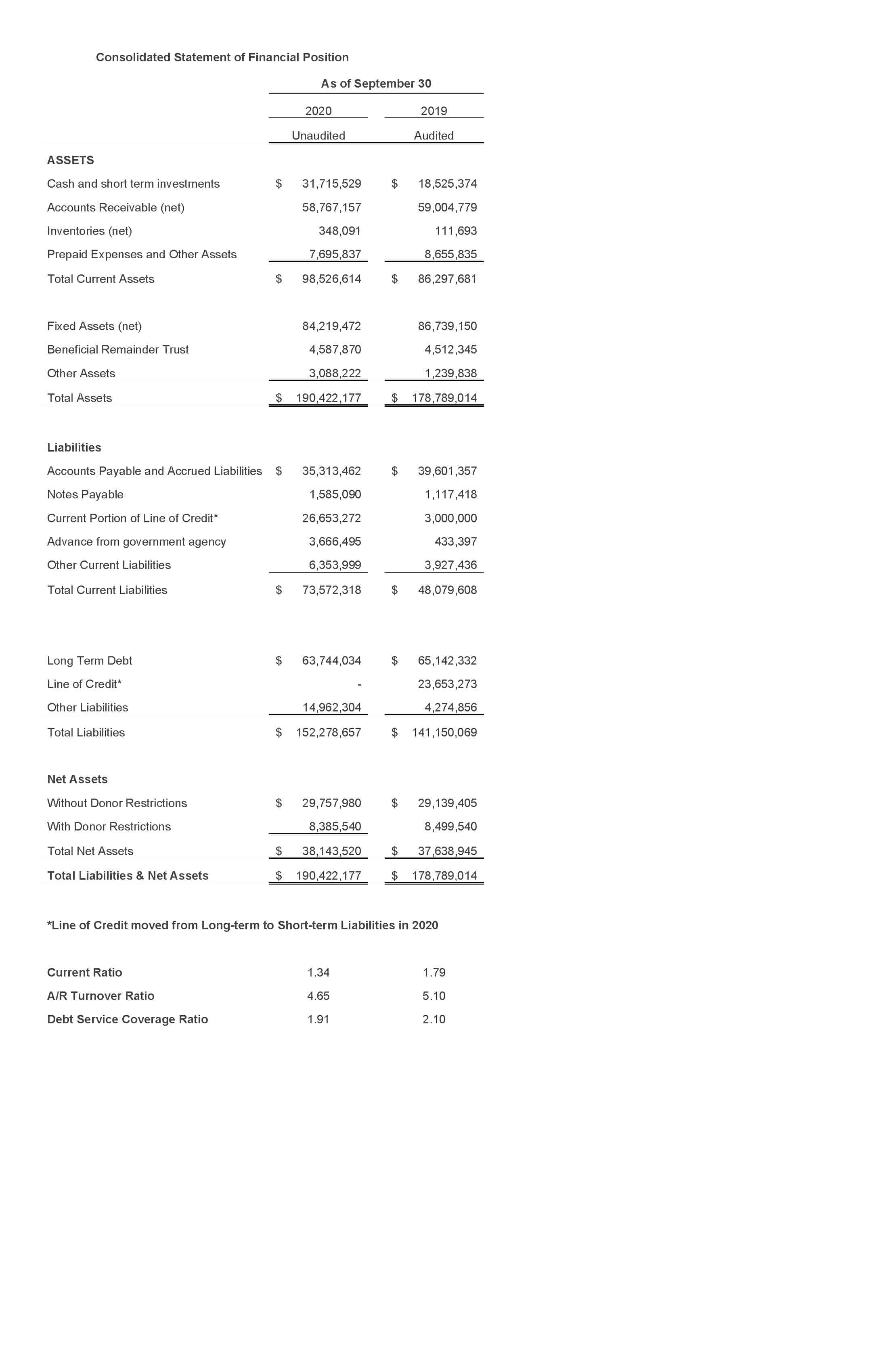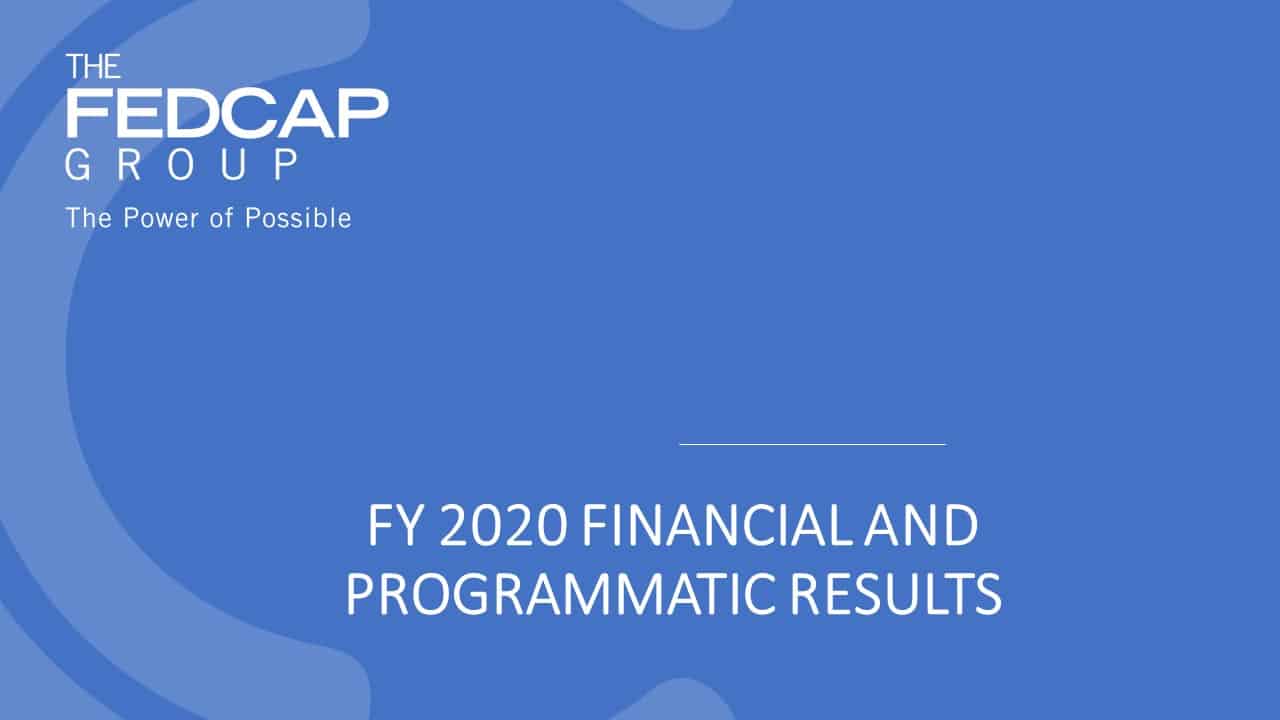The Fedcap Group Reports Fiscal Year 2020 Operating and Financial Results
--Resilient performance supported by a strong programmatic, financial and technology infrastructure--
- Remained fully operational while ensuring health and safety of personnel and clients.
- Provided frontline services across our diversified platform.
- Maintained our strong financial position,
- Positioned The Fedcap Group to address post-pandemic challenges and opportunities.
New York, December 11 – The Fedcap Group, the parent company for a growing network of top tier nonprofit agencies, today reported its operating and financial results for fiscal year 2020 ending September 30, 2020. Committed to providing services that positively impact the lives of people with barriers to social and economic well-being, The Fedcap Group operates in four main practice areas: Education, Workforce Development, Occupational Health and Economic Development.
Management Comment
“The Fedcap Group’s fiscal 2020 performance demonstrated the resilience of our organization and our ability to manage effectively through the challenges of COVID-19. We have remained operational throughout this unprecedented health crisis, providing a broad range of services to consumers, while maintaining strict safety protocols to protect our staff. At the same time, we took action to optimize The Fedcap Group’s financial position to ensure the sustainability of our work, ending the year with relatively stable year-on-year recurring revenue levels, a strong cash position, and expanded bank credit lines,” said Christine McMahon, President and Chief Executive Officer.
“Nowhere has the pandemic been more acutely felt than in our at-risk communities, where individuals are suffering high infection rates, loss of income and a pullback in available services. We are proud of how well The Fedcap Group has been able to utilize our robust platform to provide much needed help, including: distributing over 50 tons of food, toiletries, and other essentials through our child development centers and special education schools, cooking over 160,000 meals for the homeless and food insecure in our commercial kitchen, providing childcare to health care providers and first responders, and offering remote telehealth services to tens of thousands of individuals. Similarly, our facilities management subsidiary has deep cleaned over 18 million square feet of commercial space to provide a safe working environment for thousands of individuals.
“As our staff worked tirelessly since March to address the special pandemic-related needs in our communities, 2020 was also a year in which we continued to refine our work in our five key areas of focus: Children ages 0-8, youth transitioning from foster care, individuals with intellectual and developmental disabilities (I/DD), the previously incarcerated and those on public assistance. Throughout the year, we made targeted investments to enhance our technology infrastructure, enabling the transition to work-from-home and upgrading our financial, HR, fundraising and business development systems to create a sustainable platform from which to efficiently serve our diversified populations.
2020 Financial and Operating Metrics
Revenue for FY 2020 was $273.1 million, stable on a recurring revenue basis with the prior fiscal year. Lower year-on-year comparisons of reported revenue primarily reflect the downsizing of our home health business, which contributed additional revenues of approximately $6.7 million in 2019 and the wind-down of a large project that generated revenues of $25.2 million last year.
Over the last several years, The Fedcap Group has significantly diversified its revenue sources, bringing a broader array of services to at-risk populations.
- Economic Development is comprised of business services operations that directly employ the populations we serve. In fiscal year 2020 we employed over 1,700 people in these businesses, the majority of whom have disabilities or other barriers. Within this activity, the largest unit is Total Facilities Management, which provides services at many iconic sites in the U.S. and at government and commercial office buildings. During this pandemic, client demand for Total Facilities Management has increased significantly, and we have worked diligently to meet the increased cleaning needs of the over 18MM square feet of space that we maintain.
- Workforce Development continues to represent the area in which The Fedcap Group serves the largest number of individuals through a broad range of services, including the Single Stop platform. In 2020 we provided functional capacity assessments, employment readiness training, vocational evaluations, and wellness services to 23,000 people. We placed just under 9,000 people in jobs and provided job retention services. We have continued to provide most of these services via video conferencing and technology platforms during the current healthcare crisis.
- Education and Occupational Health represent growing bodies of work in early childhood services provided through Easterseals and in our programs assisting individuals with intellectual and developmental disabilities (I/DD) enter the workforce. We provided services to 6,535 children ages 0-8, designing and delivering an array of evidence-based practices that promote long term economic and social well-being. The Fedcap Group is also at the forefront of helping individuals with I/DD learn new trades and enter the workforce at competitive wages. Transitioning this work to a telehealth model during COVID-19 has involved engagement of families and a learning curve for staff.
Fiscal 2020 operating expenses were $272.6 million, 88% of which represented direct program expenses. The Fedcap Group reported an operating gain of $504 thousand for the year ended September 30, 2020, largely reflecting the organization’s agility during the COVID-19 crisis, pivoting to delivering services remotely, expanding COVID-related services and managing expenses in areas where revenues were impacted by the crisis.
At September 30, 2020, cash and marketable securities were $31.7 million, of which $12.5 million represented federal government-funded loans as part of the Payroll Protection Plan (PPP). At the end of fiscal 2019, cash and marketable securities were $18.5 million.
During FY20, The Fedcap Group began the process of increasing its working capital line of credit to enable the organization to effectively bid for many growth opportunities that exist. In October 2020, The Fedcap Group refinanced a portion of its outstanding debt. The line of credit capacity was increased to $42.5 million from $25 million and long-term debt was decreased by $4 million.
Summary and Outlook
“Fiscal 2020 was a tale of two halves. In the first half of the year, Fedcap was moving forward with its growth strategy, achieving positive outcomes for individuals in need, winning new contracts including a large new workforce development contract in Canada, and engaging in talks with potential acquisition candidates.
“At the onset of the pandemic, we pivoted quickly to address the dire situations that existed in many of our communities. I could not be prouder of The Fedcap Group leadership and staff who have worked diligently to bring our essential services to the at-risk populations we serve within a very difficult operating environment. This demonstrates the strong culture that unites us and supports our confidence in The Fedcap Group’s ability to continue to effectively navigate the COVID-19 health crisis and to emerge from it as an even stronger organization.
“While the pandemic caused delays in several of our initiatives, we are pleased to report that in the 4th quarter of fiscal 2020, we officially brought Apex Technical School into The Fedcap Group. Since 1961, Apex Technical School has enjoyed a rich tradition of service to New Yorkers. Licensed by the New York State Education Department, the school’s founders were marine, stationary and refrigeration engineers who were well known in union and trade association activities. They developed a trade school for the purposes of offering a hands-on quality education. Nearly 60 years later, Apex continues to provide educational opportunities that change lives. Each year, 1000+ individuals graduate with skills and certifications in trades with tremendous growth potential. This combination allows us to expand our ability to assist unemployed individuals develop new skills, especially in the area of technology, and compete in the changing marketplace.
“We have also ramped-up our large Canadian workforce contract and are now serving a population of more than 10,000 people across Ontario. Additionally, we continue to expand our presence in the UK and we were recently selected by the UK Department of Work and Pensions (DWP) as one of 14 organizations (and the only nonprofit agency) eligible to compete for new workforce development contracts worth £2.9 billion over 4 years, throughout England, Scotland and Wales.
“We believe that the post-COVID-19 environment will provide opportunities for The Fedcap Group and similar service providers that are well-capitalized and have the scale and IT infrastructure to offer robust solutions to funders. We already are seeing greater demand for our on-premises Facilities Management Services and have added over 40 individuals to implement contract plus-ups we have received, to increase the scope of our work in this arena. There also will be expanded need for our workforce training and development work to help get individuals back to work.
“Operating in 22 states and Canada, Scotland and England, we are a leader in providing relevant services. Our strong financial position and the dedication of our staff give us confidence in The Fedcap Group’s ability to remain a sustainable organization supported by a strong programmatic, financial and technology infrastructure,” said Ms. McMahon.
About The Fedcap Group
For 85 years, The Fedcap Group has developed scalable, innovative and potentially disruptive solutions to some of society’s most pressing needs. Serving over 265,000 people each year, The Fedcap Group provides educational services to every age group, vocational training in high-growth industries, behavioral health services, work readiness skill building and jobs—all targeted to helping people achieve long-term self-sufficiency.
Conference Call Details
Date: December17, 2020 at 11:00am ET
Webcast:
US: 1-844-792-3735
UK: 08002799489
Canada: 1-855-669-9657
Contact:
Ariana Reed Casasanto
646-931-2412
acasasanto@fedcap.org
Financials
Consolidated Statement of Financial Position as of September 30

Consolidated Statement of Activities as of September 30








 Granite Pathways’ Strength to Succeed (STS) program helps its participants catch up on utility bills. One of our Parent Partners recently shared how this program prevented a family we serve from losing their home this holiday season.
Granite Pathways’ Strength to Succeed (STS) program helps its participants catch up on utility bills. One of our Parent Partners recently shared how this program prevented a family we serve from losing their home this holiday season. 




